-

新人教版高中英语选修2Unit 2 Reading for writing教学设计
The theme of this section is to express people's views on studying abroad. With the continuous development of Chinese economic construction, especially the general improvement of people's living standards, the number of Chinese students studying abroad at their own expense is on the rise. Many students and parents turn their attention to the world and regard studying abroad as an effective way to improve their quality, broaden their horizons and master the world's advanced scientific knowledge, which is very important for the fever of going abroad. Studying abroad is also an important decision made by a family for their children. Therefore, it is of great social significance to discuss this issue. The theme of this section is the column discussion in the newspaper: the advantages and disadvantages of studying abroad. The discourse is about two parents' contribution letters on this issue. They respectively express their own positions. One thinks that the disadvantages outweigh the advantages, and the other thinks that the advantages outweigh the disadvantages. The two parents' arguments are well founded and logical. It is worth noting that the two authors do not express their views on studying abroad from an individual point of view, but from a national or even global point of view. These two articles have the characteristics of both letters and argumentative essays1.Guide the students to read these two articles, and understand the author's point of view and argument ideas2.Help the students to summarize the structure and writing methods of argumentative writing, and guides students to correctly understand the advantages and disadvantages of studying abroad3.Cultivate students' ability to analyze problems objectively, comprehensively and deeply

新人教版高中英语选修2Unit 2 Using langauge-Listening教学设计
? B: Absolutely! Getting involved with Chinese cultural activities there definitely helped a lot. I got to practice my Chinese on a daily basis, and I could learn how native Chinese speakers spoke.? A: What do you feel is your biggest achievement?? B: Learning Chinese characters! I have learnt about 1,500 so far. When I first started, I didn't think it was even going to be possible to learn so many, but now I find that I can read signs, menus, and even some easy newspaper articles.? A: What are you most keen on?? B: I've really become keen on learning more about the Chinese culture, in particular Chinese calligraphy. As I have learnt Chinese characters, I have developed a great appreciation for their meaning. I want to explore Chinese characters by learning how to write them in a more beautiful way. ? A: Finally, what do you want to say to anyone interested in learning Chinese?? I have really become keen on learning more about the Chinese culture, in particular Chinese Calligraphy. As I have learnt Chinese character, I have developed a great appreciation for their meaning. I want to explore Chinese characters by learning how to write them in a more beautiful way.? A: Finally, what do you want to say to anyone interested in learning Chinese?? B: I'd say, give it a shot! While some aspects may be difficult, it is quite rewarding and you will be happy that you tried.? A: Thanks for your time. ? B:You're welcome.

新人教版高中英语选修2Unit 3 Using langauge-Listening教学设计
1. How is Hunan cuisine somewhat different from Sichuan cuisine?The heat in Sichuan cuisine comes from chilies and Sichuan peppercorns. Human cuisine is often hotter and the heat comes from just chilies.2.What are the reasons why Hunan people like spicy food?Because they are a bold people. But many Chinese people think that hot food helps them overcome the effects of rainy or wet weather.3.Why do so many people love steamed fish head covered with chilies?People love it because the meat is quite tender and there are very few small bones.4.Why does Tingting recommend bridge tofu instead of dry pot duck with golden buns?Because bridge tofu has a lighter taste.5 .Why is red braised pork the most famous dish?Because Chairman Mao was from Hunan, and this was his favorite food.Step 5: Instruct students to make a short presentation to the class about your choice. Use the example and useful phrases below to help them.? In groups of three, discuss what types of restaurant you would like to take a foreign visitor to, and why. Then take turns role-playing taking your foreign guest to the restaurant you have chosen. One of you should act as the foreign guest, one as the Chinese host, and one as the waiter or waitress. You may start like this:? EXAMPLE? A: I really love spicy food, so what dish would you recommend?? B: I suggest Mapo tofu.? A: Really ? what's that?

新人教版高中英语选修2Unit 4 Learning about Language教学设计
This section guides students to pay attention to the typical context of vocabulary use, helps students accumulate vocabulary around the key vocabulary of this unit, and uses the learned words and word chunks in different contexts to deeply understand their meaning and usage, so as to achieve the purpose of review and consolidation.The teaching design activities aim to guide students to pay attention to the typical context in which the target vocabulary is used, as well as the common vocabulary used in collocation, so that students can complete the sentence with correct words. In terms of vocabulary learning strategies, this unit focuses on cultivating students' ability to pay attention to collocation of words and to use word blocks to express meaning.For vocabulary learning, it is not enough just to know the meaning of a single word, but the most important thing is to master the common collocations of words, namely word blocks.Teachers should timely guide students to summarize common vocabulary collocation, such as verb and noun collocation, verb and preposition collocation, preposition and noun collocation, and so on.1. Guide students to understand and consolidate the meaning and usage of the vocabulary in the context, 2. Guide the students to use the unit topic vocabulary in a richer context3. Let the students sort out and accumulate the accumulated vocabulary, establishes the semantic connection between the vocabulary,4. Enable students to understand and master the vocabulary more effectivelyGuiding the Ss to use unit topic words and the sentence patterns in a richer context.

新人教版高中英语选修2Unit 4 Reading for writing教学设计
假定你是英国的Jack,打算来中国旅行,请你给你的中国笔友李华写一封信,要点如下:1.你的旅行计划:北京→泰山→杭州;2.征求建议并询问他是否愿意充当你的导游。注意:1.词数80左右(开头和结尾已给出,不计入总词数);2.可以适当增加细节,以使行文连贯。参考词汇:故宫 the Forbidden City;泰山 Mount TaiDear Li Hua,I'm glad to tell you that 'm going to visit China.First,I am planning to visit Beijing,the capitalof China,where I am looking forward to enjoying the Great Wall,the Forbidden City and somebeautiful parks.Then I intend to go to visit Mount Tai in Shandong Province.I've heard that it is one ofthe most famous mountains in China and I can't wait to enjoy the amazing sunrise there.After that,I amalso going to Hangzhou.It is said that it is a beautiful modern city with breathtaking natural sights,among which the West Lake is a well- known tourist attraction.What do you think of my travel plan? Will you act as my guide? Hope to hear from you soon.

新人教版高中英语选修2Unit 5 Learning about Language教学设计
The purpose of this section of vocabulary exercises is to consolidate the key words in the first part of the reading text, let the students write the words according to the English definition, and focus on the detection of the meaning and spelling of the new words. The teaching design includes use English definition to explain words, which is conducive to improving students' interest in vocabulary learning, cultivating their sense of English language and thinking in English, and making students willing to use this method to better grasp the meaning of words, expand their vocabulary, and improve their ability of vocabulary application. Besides, the design offers more context including sentences and short passage for students to practice words flexibly.1. Guide students to understand and consolidate the meaning and usage of the vocabulary in the context, 2. Guide the students to use the unit topic vocabulary in a richer context3. Let the students sort out and accumulate the accumulated vocabulary, establishes the semantic connection between the vocabulary,4. Enable students to understand and master the vocabulary more effectivelyGuiding the Ss to use unit topic words and the sentence patterns in a richer context.Step1: Read the passage about chemical burns and fill in the blanks with the correct forms of the words in the box.

新人教版高中英语选修2Unit 5 Reading and thinking教学设计
The theme of this activity is to learn the first aid knowledge of burns. Burns is common in life, but there are some misunderstandings in manual treatment. This activity provides students with correct first aid methods, so as not to take them for granted in an emergency. This section guides students to analyze the causes of scald and help students avoid such things. From the perspective of text structure and collaborative features, the text is expository. Expository, with explanation as the main way of expression, transmits knowledge and information to readers by analyzing concepts and elaborating examples. This text arranges the information in logical order, clearly presents three parts of the content through the subtitle, accurately describes the causes, types, characteristics and first aid measures of burns, and some paragraphs use topic sentences to summarize the main idea, and the level is very clear.1. Guide students to understand the causes, types, characteristics and first aid methods of burns, through reading2. Enhance students’ ability to deal withburnss and their awareness of burns prevention3. Enable students to improve the ability to judge the types of texts accurately and to master the characteristics and writing techniques of expository texts.Guide students to understand the causes, types, characteristics and first aid methods of burns, through readingStep1: Lead in by discussing the related topic:1. What first-aid techniques do you know of ?CPR; mouth to mouth artificial respiration; the Heimlich Manoeuvre

新人教版高中英语选修2Unit 5 Using langauge-Listening教学设计
The theme of this section is to learn how to make emergency calls. Students should learn how to make emergency calls not only in China, but also in foreign countries in English, so that they can be prepared for future situations outside the home.The emergency telephone number is a vital hotline, which should be the most clear, rapid and effective communication with the acute operator.This section helps students to understand the emergency calls in some countries and the precautions for making emergency calls. Through the study of this section, students can accumulate common expressions and sentence patterns in this context. 1.Help students accumulate emergency telephone numbers in different countries and learn more about first aid2.Guide the students to understand the contents and instructions of the telephone, grasp the characteristics of the emergency telephone and the requirements of the emergency telephone.3.Guide students to understand the first aid instructions of the operators.4.Enable Ss to make simulated emergency calls with their partners in the language they have learned1. Instruct students to grasp the key information and important details of the dialogue.2. Instruct students to conduct a similar talk on the relevant topic.Step1:Look and discuss:Match the pictures below to the medical emergencies, and then discuss the questions in groups.

人教版高中生物必修1ATP的主要来源—细胞呼吸说课稿
(一)自主阅读:自主阅读有氧呼吸三阶段内容,明确有氧呼吸的场所、反应物、生成物和释放的能量状况等内容。(二)直观教学:通过多媒体辅助教学软件,化静为动,化抽象为具体, 增强了教学内容的直观性和启发性。 .(三)比较法:学生参与完成有氧呼吸三阶段区别的表格,进行教学反馈;比较有氧呼吸和有机物体外燃烧的不同,进一步认清有氧呼吸的特点。(四)归纳法: 归纳有氧呼吸的概念。三.教学过程分析步骤一: 导入新课 通过问题探讨导入本节内容第三节 ATP的主要来源 ——细胞呼吸步骤二: 联系生活(酵母菌可用于发面和酿酒) 介绍细胞呼吸概念一、细胞呼吸的方式 :有氧呼吸、无氧呼吸步骤三: 回顾第三章细胞器的知识,学习 二、(一)有氧呼吸的主要场所——线粒体的结构

人教版高中生物必修1细胞膜—系统的边界说课稿
(1)问题串设计:①选材:选择什么细胞做材料?②为什么选择哺乳动物成熟的红细胞做实验材料?(在教师的指导下讨论分析)③怎样才能获得细胞膜?(教师讲授)(2)指导学生观看多媒体播放教参CD中的这个实验,同时教师加以讲解(3)学生分组实验(4)总结实验并加以评价设计意图:体会实验材料的正确选择对于科学研究的重要性,提高学生科学研究素养。学生在已有知识的基础上思考,尝试找出实验的原理,实现亲身体验、自主思考的的过程,这样加深学生的印象。培养学生拓展迁移的能力,使学生认识先进的生物学研究仪器。环节3.细胞膜的功能(1)学生自主学习并归纳总结:P42(2)展示图片加强理解:图片(3)讨论:联系生活实际,列举现实生活中有什么东西与细胞膜的功能相近?设计意图:提高学生自主学习的能力;注重与现实生活的联系,引导学生利用类比的方法解决问题,便于学生理解和掌握。环节4. 植物细胞的细胞壁
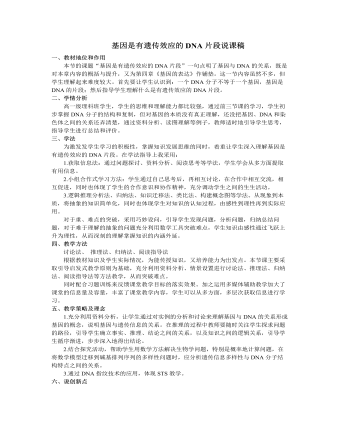
人教版高中生物必修2基因是有遗传效应的DNA片段说课稿
1.基因的化学组成:每个基因含有成百上千个脱氧核苷酸。讲述:基因的脱氧核苷酸排列顺序代表遗传信息。2.基因不同的实质:不同的基因,四种脱氧核苷酸的排列顺序不同,但是每个基因都有特定的排列顺序。3.基因的位置:染色体是基因的主要载体,每个染色体含有一个DNA分子,每个DNA分子含有多个基因,基因在染色体上呈直线排列。4.基因是有遗传效应的DNA片段这就是说,基因是DNA的片段,但必须具有遗传效应(指具有复制、转录、翻译、重组突变及调控等功能)。有的DNA片段属间隔区段,没有控制性状的作用,这样的DNA片段就不是基因。控制某种性状的基因有特定的DNA片段,蕴含特定的遗传信息,可以切除,可以拼接到其他生物的DNA上,从而获得某种性状的表达。例如:把牛的胰岛素基因拼接到大肠杆菌的DNA上,大肠杆菌可以生产胰岛素。
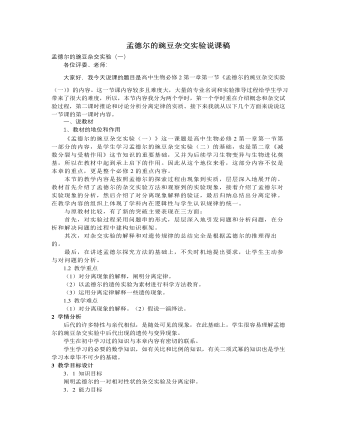
人教版高中生物必修2孟德尔的豌豆杂交实验说课稿
一、说教材1、教材的地位和作用《孟德尔的豌豆杂交实验(一)》这一课题是高中生物必修2第一章第一节第一部分的内容,是学生学习孟德尔的豌豆杂交实验(二)的基础,也是第二章《减数分裂与受精作用》这节知识的重要基础,又并为后续学习生物变异与生物进化奠基,所以在教材中起到承上启下的作用。因此从这个地位来看,这部分内容不仅是本章的重点,更是整个必修2的重点内容。本节的教学内容是按照孟德尔的探索过程由现象到实质,层层深入地展开的。教材首先介绍了孟德尔的杂交实验方法和观察到的实验现象,接着介绍了孟德尔对实验现象的分析,然后介绍了对分离现象解释的验证,最后归纳总结出分离定律。在教学内容的组织上体现了学科内在逻辑性与学生认识规律的统一。与原教材比较,有了新的突破主要表现在三方面:

人教版高中生物必修3第一章第一节《细胞生活的内环境》说课稿
1. 该节内容属于人教版高中生物必修三《稳态与环境》第一章第一节的内容:细胞生活的环境。本节内容主要突出的是内环境的概念,为下一节稳态的重要性及下一章动物和人的生命活动的调节做铺垫。2. 教学目标:(1)知识目标:①描述内环境的组成和理化性质。②说明内环境是细胞与外界环境进行物质交换的媒介。(2)能力目标:①通过思考与讨论培养学生语言表达能力②通过相关练习培养学生知识迁移的能力(3)情感目标:关注维持内环境稳态与健康的关系。*目标确定依据:主要根据课标要求及教材内容特点。3.重难点及依据(1)重点:①内环境的组成和理化性质。②内环境是细胞与外界环境进行物质交换的媒介。*依据:根据课标要求,同时是高考考点。(2)难点:①内环境的组成和理化性质。②内环境是细胞与外界环境进行物质交换的媒介。* 依据:学生缺少相关的有机化学的知识基础,且内容相对枯燥抽象。
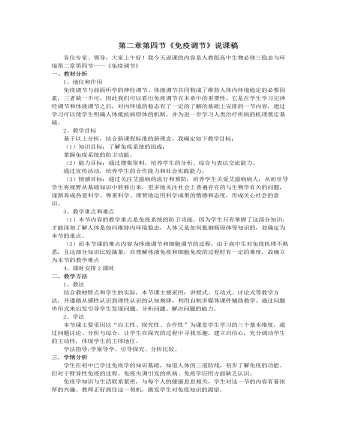
人教版高中生物必修3第二章第四节《免疫调节》说课稿
(四)、活动交流,体验科学通过资料分析讨论以下三个问题:1、你知道爱滋病的传播途径吗?2、如何预防爱滋病?3、我们应如何对待爱滋病患者?面对艾滋病我们能做些什么?从而进入情感态度的教育。除此之外,我还设计一个开放性的作业“向全社会为关注艾滋病设计一个宣传广告”(形式不限,漫画、板书、倡议书等),让学生把爱心付诸于实际行动。在此基础上引出“免疫学的应用”从免疫预防、免疫治疗、器官移植三个方面讲述,让学生充分体验到知识和社会生活的紧密联系,让他们不在感到科学是那么的遥远,而是可爱的有用的。通过交流,让同学们体会到合作的魅力和重要性,进一步培养合作意识和合作能力。最后我设计一个资料搜集,让同学们选一个感兴趣的主题利用电脑在网上搜集有关资料。主题:1、你知道世界艾滋病日吗?历年的主题是什么?开展世界艾滋病运动有什么意义?
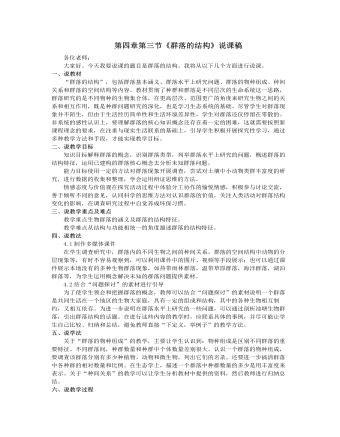
人教版高中生物必修3第四章第三节《群落的结构》说课稿
建构群落特征3群落有一定的空间结构,包括垂直结构和水平结构。思维拓展从结构与功能相统一的角度思考群落内的分层结构的意义。6.4运用群落核心知识概念解决未知群落问题学生已掌握了同一时间内聚集在一定区域中各种生物种群的集合是生物群落,所有群落都有一定的物种组成、种间关系、空间结构,不同群落主要表现在其具体特征上的差异。在此基础上,为学生提供新的问题情境,利用多媒体课件,展示不同生态环境下不同生物群落问题,让学生运用已建构的群落概念,通过分析、演绎和具体化等辩证思维的过程解决未知的群落问题,课件展示热带雨林、温带草原、海洋、湖泊等生物群落。学生运用概念说明不同的群落的物种丰富度差异,列举不同群落的种间关系,分析不同群落的垂直结构和水平结构,研究造成不同群落重要特征差异的原因。评价人类的活动对群落的结构的影响。

人教版高中生物必修1细胞器—系统内的分工合作说课稿
②与学牛的牛活经验相关,有利激发学列的兴趣。⑧利用多媒体让学牛通过观看、比较、讨论,加深理解f-J利掌握细胞内的牛要细胞器的结构及其功能。④学牛白丰学习,丰动建构新知识。⑤为完成后面的达标图表做充分的准备。4、概括反馈:①设讣达标表格,引导学牛完成。②应用该表格进行小结。③推荐相关网站,以解决课后遇到的附加题。这样设置的理由是①通过完成表格,归纳各种细胞器的结构和功能,使学牛更好的掌握本节课的内容。②培养学牛的分析问题和归纳总结的能力③培养学牛的竞争意识和团队合作精神。④拓展了教育资源,为学牛提供了一个白丰学习的空间。[课堂小结]请4-5位学牛来总结本节课的学刊内容和白己掌握的情况。请教师重新出示“八种细胞器的比较表”和“植物细胞和动物细胞的比较表”对本节内容的知识点、重点、难点进行总结。

人教版高中历史必修3物理学的重大进展说课稿2篇
二、相对论的创立【课件】展示下列材料艾伯特·爱因斯坦(1879——1955),1879年3月14日诞生在德国乌尔姆的一个犹太人家中。1894年举家迁居意大利米兰。1900年毕业于瑞士苏黎世工业大学。爱因斯坦被认为是最富于创造力的科学家,他不但创立了相对论,还提出了光量子的概念,得出了光电效应的基本定律,并揭示了光的波粒二重性本质,为量子力学的建立奠定基础。为此荣获1921年度的诺贝尔物理学奖。同时,他还证明了热的分子运动论,提出了测定分子大小的新方法。【问题】19世纪末20世纪初爱因斯坦对物理学的贡献是什么?意义是什么?为什么会出现?1、背景:经典物理学的危机。19世纪末三大发现:x射线、放射性和电子,经典力学无法解释研究中的新问题,如:黑体辐射、光电效应等。2、相对论的提出及主要内容:(1)“狭义相对论”和光速不变原理:1905年提出。
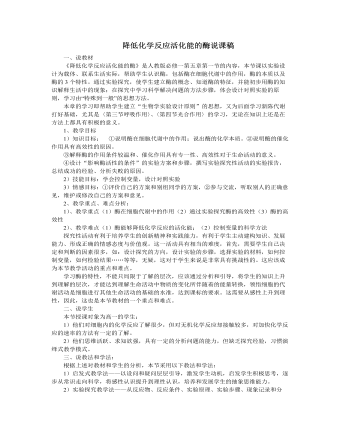
人教版高中生物必修1降低化学反应活化能的酶说课稿
实验是学习生物的手段和基础,是培养学生分析问题、解决问题的能力及创造能力的载体。新课程倡导:强调过程,强调学生探索新知识的经历和获得新知的体验,不能在让教学脱离学生的内心感受,必须让学生追求过程的体验。并且每年高考都有对生物学实验的考查,而且比例越来越重,而学生的失分比例大,主要在于他们没有完整的生物实验设计模式,考虑问题欠缺,本节安排在第二课时完整讲述高中生物学实验设计,是以学生在第一课时和前面探究实验接触的前提下,完整体验生物实验设计模式,为后面学习探究实验打下基础,也为培养学生分析问题、解决问题从一开始就打好基础。五、说教学过程:第一课时联系生活,导入新课,激发学生学习兴趣→细胞代谢→问题探究,酶在代谢中的作用,掌握科学实验方法→酶的本质,运用方法,自主归纳获取新知→小结练习,突出重点易化难点
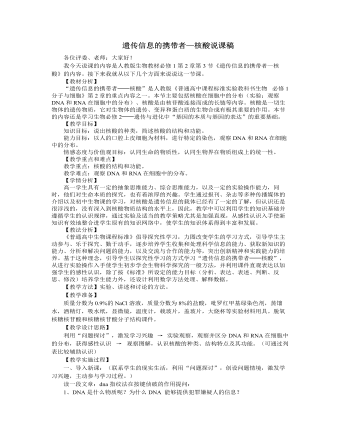
人教版高中生物必修1遗传信息的携带者—核酸说课稿
二、问题导学,主动探究,获取知识:(给学生机会,参与学习过程,有利于对知识的感知和对科学研究方法的领悟。有利于突破难点。)通过上面的讨论及对初中相关知识的回忆可知,核酸是生物体内的遗传物质。提问:1 、你知道生物体内的核酸有几种?它们在细胞中是如何分布的? 2 、如何观察核酸在细胞中的分布? 针对问题,引导学生阅读教材及相关实验内容,组织学生进行实验。让学生阅读课文及“观察DNA 和RNA 在细胞中的分布”实验,回答问题。实验后要倾听、总结学生的实验结论,继续引发学生思考:原核细胞的DNA位于细胞内的什么部位?三、加工、整合信息, 构建知识体系。(充分利用教材中图示和课件的直观性特点,发挥学生主体作用,引导学生通过观察、讨论,感知知识的形成,突出重点)组织学生阅读教材并讨论: 1、核酸同蛋白质一样,也是生物大分子物质,那么,核酸由哪些元素组成?组成它的基本单位是什么? 2、DNA 和RNA的化学组成有何异同? 3、组成核酸的碱基、五碳糖、核苷酸各有几种?
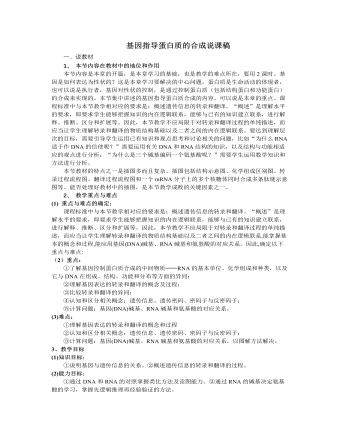
人教版高中生物必修2基因指导蛋白质的合成说课稿
六、说教学反思由于本节内容抽象复杂, 插图多, 涉及的物质种类也比较多,应要求学生做好课前预习。教学中,在处理主干知识和侧枝内容的关系时,要做到合理分配时间,明确不同内容的教学要求。教师要注意将知识及时进行归纳、比较和总结。要让学生了解各个知识点间的内在关系,又要能简洁、清晰地概述转录和翻译的过程。教师在备课时,一定要仔细分辨并揣摩插图所表达的意思,并能将不同的插图内容与教学流程有机地结合起来。在对插图的处理上,还应分清主次和轻重。教材在呈现教学内容时,采用图文并茂的方式来揭示转录与翻译的动态过程。因此,教师不仅要利用插图达到形象和直观的教学效果,还应配合教材中的文字描述作深入浅出的讲解,使文字信息与图形信息结合起来,让学生感知到基因的表达是一个多层次的、动态的、相互协调和配合的过程。尽可能利用多媒体课件进行教学。多媒体课件可以形象、生动地反映基因表达的过程,这是纸质教材难以做到的。

